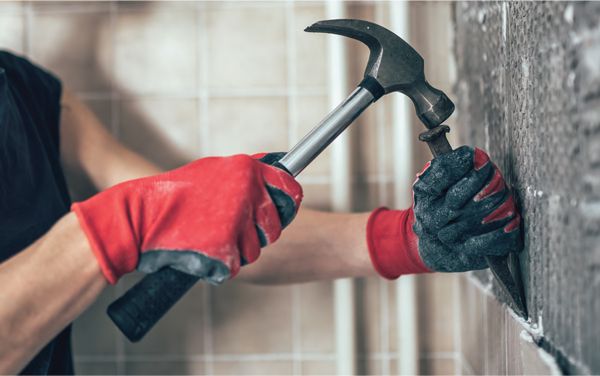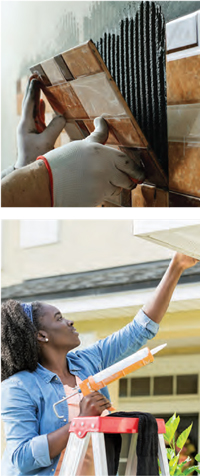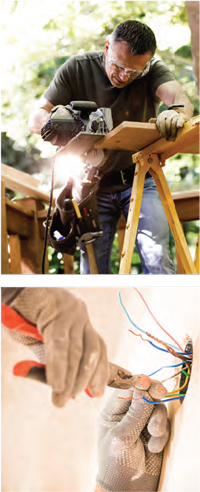DIY VS. PRO | The True Costs and Benefits of Doing It Yourself

It starts innocently enough. You’re watching an HGTV marathon. Hours pass as you consume a buffet of 30- to 60-minute tales on house flipping, smart designing, and DIY tackling. Property Brothers, House Hunters, Good Bones—oh my! Fixer Upper, Flip or Flop, Hidden Potential—time flies!

The addictive factor is built upon a foundation of instant gratification in quick successions of “before” and “after” images with a bit of blood, sweat and tears mixed in. “I bet I can do that,” you muse as you recruit a bit of “expert” help à la YouTube and then roll up your sleeves.
Fast forward a few hours, and you are knee-deep in a smoking heap of debris, clumsily clutching a power tool of some sort. Sirens can be heard not too far in the distance. “How did I get here?” you wonder with disenchantment.
Misguided DIY undertakings have left many a homeowner with more regret than return. When should you get your hands dirty, and when should you call in a contractor? It all comes down to several factors.

Time availability
If you have a true passion for DIY, lots of free time, no urgent tasks competing for your attention, and desire for a challenge, then more power to you. Accumulate any knowledge necessary for your DIY project and go forth. On the other hand, if you currently have a full plate of work, community activities and childrearing duties, proceed with caution. Sometimes less is more. Painting, for example—although requiring some planning with set-up and brush stroke precision—can be an excellent first DIY venture. YouTube can equip you with all the information you’ll need to get started. The drastic aesthetic change will be instantly gratifying. Landscaping similarly offers the opportunity for a relatively low-risk creative adventure. Pick the brain of an expert at a local garden shop, and quickly learn the ins and outs of local climate conditions and soil, as you work toward enhancing your home’s curb appeal. Another area for lower effort beautification is interior décor. Depending on your budget, you can delight in decorating your home to suit your personal taste. Home staging is a topic that abounds on Instagram, YouTube, and Pinterest. Flip through your latest issue of HOME or browse your favorite apps for some inspiration, and then shop to your heart’s content for furniture, art, or inexpensive novelty knickknacks.

Level of difficulty
If you grew up as the son or daughter of a contractor and spent summers in your youth renovating residential or commercial properties, you’re better prepared to flip a home than someone whose sweat equity consists of hours spent viewing Love It or List It. No need for regret or looking back at roads not taken. Simply take an inventory of your current skillset. If you want a complicated task completed soon, neither YouTube nor any other how-to reference will suffice. Listed on Realtor.com, among “6 DIY Projects You Should Never Do Yourself,” are molding, floor refinishing, electrical work, tiling, roofing, or any trade that requires permitting. There’s a good reason why plumbing and hot water heater repairs are typically handled by a plumber, electrical work by an electrician, and roofing by a roofer. These are highly technical skills that require knowledge and licensure beyond that of the average homeowner.
WHEN MULLING OVER A POTENTIAL DIY-DO OR DON’T, CONSIDER THE 4 Fs
FINANCES
Will this project add resale value to your home? Does tackling this project as a solo mission free up your funds for other pursuits? If you sit down and crunch numbers for the cost of supplies and time required, can you prove bang for your buck? Would that buck be better spent on an expert’s touch? According to nerdwallet.com, a whopping 43% of homeowners have admitted to messing up a DIY home effort at least once. How much would this project cost to fix if you don’t succeed?
FRUSTRATION
Do you have a long attention span and patience that goes on for miles? Is mastery your middle name, or has your life been a series of passion projects begun in enthusiasm and abandoned in boredom? There’s no wrong or right way to be. Some are better equipped for short-term ventures.
FLEXIBILITY
Will learning these new skills position you to pursue additional interests? Maybe you would like to get involved in the local chapter of Habitat for Humanity. Perhaps you’ve decided flipping houses is a worthwhile investment for saving for your kids’ education. Which skills will help with future pursuits?
FUN
What tickles your fancy? Are you drawn to paint swatches or pipes? Beauty or utility? Quick and easy, or slow and steady?
Follow your bliss, and decide what you are happy to pay NOT to DIY?

Safety
As Benjamin Franklin famously said, “an ounce of prevention is worth a pound of cure.” When it comes to safety, a little common sense goes a long way. If you struggle with lightheadedness, for instance, do not climb on your roof to attach shingles. Even if you are physically agile, always ask yourself if the reward is worth the risk. The National Safety Council has reported more than 6,000 deaths yearly from falls resulting from cleaning gutters or repairing roofing. Potential for fires, flooding, falls, water damage, electrocution, burns, explosions, and gas poisoning are risky territory better left in the hands of a true-blue tradesman. It is also worth noting that if your home or commercial property is noncompliant with code requirements, you may find yourself in a heap of financial or legal trouble with no quick fixes. If you lack the qualifications, save yourself the headache and risk and go with a pro.
In the words of the late great, Sir Francis Bacon, “knowledge is power.” To best ensure a positive outcome, do yourself a favor and seek knowledge before revving up that first power tool. ✦
contractor, curb appeal, diy, Fixer Upper, Flip or Flop, Hidden Potential, improve, landscaping, National Safety Council, Painting, PRO






